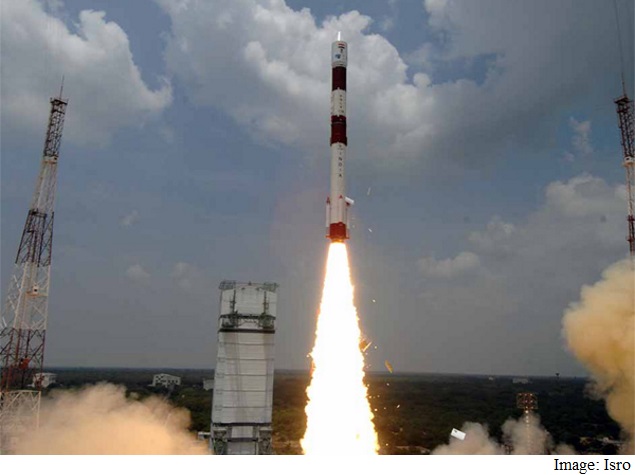- Home
- Science
- Science News
- Isro's GSLV Mark III Lifts Off With Unmanned Crew Module
Isro's GSLV-Mark III Lifts Off With Unmanned Crew Module

Precisely at 9.30am IST, the 630-tonne Geosynchronous Satellite Launch Vehicle-Mark III (GSLV-Mark III) standing 43.43 metre tall freed itself from the second launch pad holds and with a reverberating deep throated roar, it rose into the sky.
With a thick orange flame at its tail, the expendable rocket ascended towards the heavens with one way ticket as its design life span is just around five minutes.
Just over five minutes into the flight, the rocket is expected to eject the giant cup cake shaped 3.7-tonne crew module at an altitude of 126km.
The Rs.155 crores mission has twin purposes. First is to test the rocket's atmospheric flight stability powered by two engines with around four tonne luggage.
The second and incidental objective is to study the re-entry characteristics of the 3.7-tonne crew module-called Crew Module Atmospheric Re-entry Experiment - its aero braking and validation of its end-to-end parachute system.
According to an Indian Space Research Organisation (Isro) official, it will be of the size of a small bedroom and can accommodate two to three people.
The crew module would descend towards Earth after its ejection at an altitude of 126km and its speed would be remotely controlled by Isro officials by its on-board motors.
When the module reaches an altitude of 80km above Earth, the on-board thrusters would be shut off.
The module will re-enter Earth's atmosphere at a great speed and the outer temperature touching around 1,600 degrees centigrade.
At an altitude of around 15km, the module's apex cover would separate followed by the deployment of the parachutes so as to soft crash in Bay of Bengal near Andaman and Nicobar Islands.
From here the crew module would begin its multi-modal and multi-state journey.
A naval ship tracking the signals from the module will pick up the module and deliver it at the Ennore Port near Chennai in Tamil Nadu. From there it will be brought to Sriharikota in Andhra Pradesh and then it will be taken to the Vikram Sarabhai Space Centre, Thiruvanthapuram in Kerala.
The experimental rocket does not have the crucial cryogenic engine which is under development and would take around two years for realisation.
However, in order to study the rocket's structural behaviour during its ascent, Isro decided to put in a dummy cryogenic engine which is similar to the one that would actually power the vehicle.
The dummy cryogenic engine was also filled with liquid nitrogen for mass simulation, M.Y.S. Prasad, director of the Satish Dhawan Space Centre in Sriharikota, told IANS.
The GSLV-Mark III is designed to be a three stage/engine rocket with a lift off weight of 630 tonnes.
The first stage comprises two identical S-200 large solid boosters with 200 tonne solid propellant that are strapped on to the second stage, the L110 re-startable liquid stage.
The third stage/engine is the cryogenic.
For the country, Isro perfecting the cryogenic engine technology is crucial as precious foreign exchange can be saved by launching communication satellites by itself.
For the latest tech news and reviews, follow Gadgets 360 on X, Facebook, WhatsApp, Threads and Google News. For the latest videos on gadgets and tech, subscribe to our YouTube channel. If you want to know everything about top influencers, follow our in-house Who'sThat360 on Instagram and YouTube.
Related Stories
- Samsung Galaxy Unpacked 2025
- ChatGPT
- Redmi Note 14 Pro+
- iPhone 16
- Apple Vision Pro
- Oneplus 12
- OnePlus Nord CE 3 Lite 5G
- iPhone 13
- Xiaomi 14 Pro
- Oppo Find N3
- Tecno Spark Go (2023)
- Realme V30
- Best Phones Under 25000
- Samsung Galaxy S24 Series
- Cryptocurrency
- iQoo 12
- Samsung Galaxy S24 Ultra
- Giottus
- Samsung Galaxy Z Flip 5
- Apple 'Scary Fast'
- Housefull 5
- GoPro Hero 12 Black Review
- Invincible Season 2
- JioGlass
- HD Ready TV
- Laptop Under 50000
- Smartwatch Under 10000
- Latest Mobile Phones
- Compare Phones
- Infinix Smart 9 HD
- Lava Yuva Smart
- Samsung Galaxy S25 Ultra
- Samsung Galaxy S25+
- Samsung Galaxy S25
- Realme 14 Pro 5G
- Realme 14 Pro+ 5G
- Itel Zeno 10
- Asus Chromebook CR11
- Lenovo Yoga Slim 9i (2025)
- Asus ROG Flow Z13 (2025)
- Xiaomi Pad 7
- Titan Evolution
- Noise ColorFit Pro 6
- Sony 65 Inches Ultra HD (4K) LED Smart TV (KD-65X74L)
- TCL 55 Inches Ultra HD (4K) LED Smart TV (55C61B)
- Sony PlayStation 5 Pro
- Sony PlayStation 5 Slim Digital Edition
- Blue Star 1.5 Ton 3 Star Inverter Split AC (IC318DNUHC)
- Blue Star 1.5 Ton 3 Star Inverter Split AC (IA318VKU)
-
 Google Pixel 9a Spotted on EMVCo Certification Site; Model Number, Android Version Revealed
Google Pixel 9a Spotted on EMVCo Certification Site; Model Number, Android Version Revealed
-
 Budget 2025: Tech in Focus With Framework for GCCs, New 'Fund of Funds' for startups, CoE for AI
Budget 2025: Tech in Focus With Framework for GCCs, New 'Fund of Funds' for startups, CoE for AI
-
 Apple Said to Stop Development of AR Glasses for Mac Computers
Apple Said to Stop Development of AR Glasses for Mac Computers
-
 Vivo X200 Pro Mini India Launch Timeline Leaked: Expected Specifications, Features
Vivo X200 Pro Mini India Launch Timeline Leaked: Expected Specifications, Features










